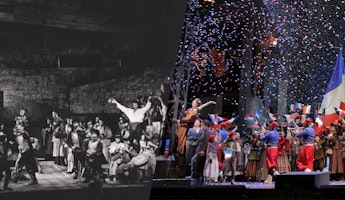Blog
April 17, 2024
The Tragic Life of Verdi
Many people think it’s not an opera season if there isn’t an opera by Giuseppe Verdi in it. Ever since the 1840s, his operas have been performed regularly in opera houses around the world and now, nearly two centuries later, audiences and musicians still can’t get enough of Verdi. One thing we’ve noticed: nearly all of Verdi’s operas end tragically. How did he craft heartbreak so beautifully? Why do his suffering characters feel so real? Well, in some ways Verdi's life was not so different from his operas, with death lurking at every corner. Seeing Verdi through this lens helps us understand how his operas reflect his own life and why our hearts still break watching his operas years later.
There are two things that were constant in Verdi’s life: music and tragedy. Depending on who you ask Verdi was born on either October 9 or 10, 1813. He became an active member of his local church’s choir by the age of six, which led to him being the church’s organist when he was 8. At that age, he also had his first encounter with death when his teacher passed away. His musical studies would eventually lead him to Milan, where he made the connections that would allow him to launch his career in opera. Death began creeping its way into Verdi’s life again in 1833 when it took his younger sister and best friend Giuseppa at the age of 17.
While all the deaths took a toll on Verdi, things were looking up for his music career. By 1835 he had a secure job as a music director. In 1836 he married Margherita Barezzi. The couple had their first child almost a year later, with a second not far behind. In 1837, Verdi premiered his first opera Oberto with success. But the happy times would soon come to an end: both of his children died within the next two years, with Margherita following soon after.
These deaths are the catalyst for much of the tragedy that came to define Verdi’s work. While Verdi vowed never to compose again after his second opera, Un giorno di regno (King for a Day, a comedy, ironically), turned out to be a major flop, he was eventually convinced to continue by the impresario of La Scala, where he signed a three-opera contract. His third opera, Nabucco, was a huge hit, and Verdi considered it the opera where his artistic career began. The opera is perhaps best known for the Act Three chorus “Va, pensiero,” which became an anthem for Italian patriots who were trying to unify and free the country from foreign control. Considering Verdi’s recent family tragedy, a different perspective may be that the chorus expresses his longing for the family that he can never return to. When looking at the chorus through that angle, it’s very easy to see how it resonated deeply with the audience. Verdi was able to channel his own heartbreak to the Israelites in the opera, making for one of the most iconic moments in operatic history.
Now let’s fast forward a couple years to what are considered Verdi’s three great “middle period” tragedies—Rigoletto, Il Trovatore and La Traviata—a trio of operas that cemented Verdi’s legacy. All three feature untimely deaths, which isn’t exactly uncommon in opera, but perhaps no composer was as familiar with untimely death as Verdi was. Even the original librettist for Il Trovatore, Salvadore Cammarano, died before the opera was completed. Did Verdi channel his experience with death into these operas? Since it’s currently on our stage, let’s look at La Traviata and see if we notice anything. The real-life woman who inspired the story, Marie Duplessis, died at the age of 23. Verdi’s wife Margherita wasn’t much older than Marie when she passed at 26. Would it be a stretch to wonder if Verdi channeled those feelings of losing his wife into Traviata?
Let us offer some more insight into the relationship between Verdi and Margherita. Verdi and Margherita originally kept their romance a secret from Margherita’s parents. Verdi was convinced that they wouldn't approve of her marrying a penniless (at the time) musician. When they did marry, Margherita’s father was embarrassed, and the local clergy outraged. But the lovers didn’t care. When Margherita became sick and passed away, her father even arrived only hours before her passing, much like Alfredo and his father in La Traviata. Verdi started work on Traviata right after seeing Dumas’ play. Did it perhaps remind him of Margherita? Perhaps he saw Dumas’ play and saw the opportunity to bring his dearly departed wife back to life on the stage, just like Dumas did with Duplessis.
You can find countless parallels like this in Verdi’s operas if you look. Is it so hard to believe that a man who lost two young children could recreate that heartbreak in the finale of Rigoletto of a father losing his daughter? In his middle-period trilogy, Verdi portrayed his tragic figures with complexity and sympathy through his music. In an art form surrounded by death, it was a composer whose life was also surrounded by it as well who gave us such eternal masterpieces. And while we can never bring back the ones that have been lost, we can continue telling their stories and bring them to life once more on stage.








/03-cosi/_dsc0996_pr.jpg?format=auto&fit=crop&w=345&h=200&auto=format)
















/05-rigoletto/hgo-rigoletto-2019-lynn-lane-2_pr.jpg?format=auto&fit=crop&w=1450&h=455h&auto=format)